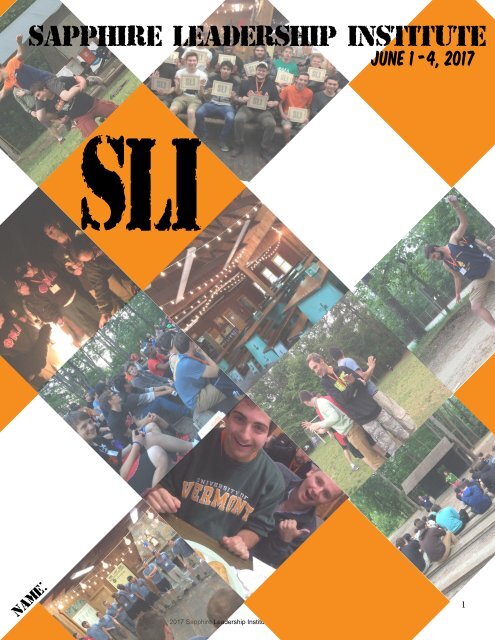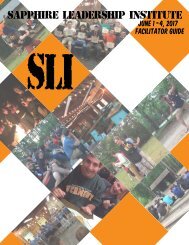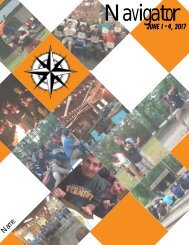SLI PARTICIPANT GUIDE
You also want an ePaper? Increase the reach of your titles
YUMPU automatically turns print PDFs into web optimized ePapers that Google loves.
SAPPHIRE LEADERSHIP INSTITUTE<br />
JUNE 1 -4, 2017<br />
<strong>SLI</strong><br />
NAME::<br />
2017 Sapphire Leadership Institute Participant Manual<br />
1
Sapphire Leadership Institute<br />
The Sapphire Leadership Institute is held biannually to assist all undergraduate members who are interested in<br />
learning more about leadership while practicing their own leadership skills in preparation for their<br />
growing role as chapter leaders.<br />
LEARNING OUTCOMES<br />
As a result of participating in Sapphire Leadership Institute, participants will…<br />
1 2<br />
3<br />
4 5<br />
Develop and improve<br />
leadership skills by<br />
participating in values<br />
centered and leadership<br />
based conversations.<br />
Develop a mentor relationship<br />
with facilitators through<br />
challenge and learning during<br />
and after the program.<br />
Create friendships and lasting<br />
relationships with other<br />
brothers through team<br />
building activities, values<br />
discussions, and<br />
brotherhood time.<br />
Separate position-based<br />
leadership from their<br />
leadership success through<br />
reflections and small group<br />
activities.<br />
Demonstrate service to<br />
the community through<br />
participating in a civic<br />
engagement project<br />
as a group.<br />
2<br />
Phi Mu Delta Fraternity
SAPPHIRE SCHEDULE<br />
DAY 1 DAY 2 DAY 3<br />
3:00 PM - Welcome!<br />
4:00-5:30 PM - Chapter Meeting<br />
One: Team Building<br />
5:30 PM - Dinner<br />
7:00-8:00 PM - Brotherhood<br />
Session: Starting With Why<br />
8:00-9:15PM - Chapter Meeting<br />
Two: Beginning to Find My Why<br />
9:15 PM - Chapter Builder Training<br />
from TechniPhi<br />
DAY 4<br />
8:00 AM - Breakfast<br />
9:00-10:15 AM - Brotherhood<br />
Session: The Discipline to Commit<br />
10:30-11:45 AM - Brotherhood<br />
Session: Accountability and<br />
Brotherhood<br />
12:00 PM - Lunch<br />
1:00-3:00 PM - Ropes Course<br />
3:30-5:00 PM - Chapter Meeting<br />
Three: Reflecting on My Why<br />
5:30 PM - Dinner<br />
7:30-8:30 PM - Brotherhood<br />
Session: Inspiring with Our Why<br />
8:45-11:00 PM - Night Walk &<br />
Creed Talk<br />
11:00 PM - Brotherhood Time<br />
7:30-8:30 AM - Clean up & Pack!<br />
8:30-9:30 AM - Breakfast<br />
9:30-10:30 AM - Graduation<br />
11:00 AM - Departure<br />
8:00 AM - Breakfast<br />
9:00-9:30 AM - Brotherhood<br />
Session: Starting with Service<br />
9:30-11:30 AM - Brotherhood<br />
Service Project<br />
12:00 PM - Lunch<br />
1:00-3:00 PM - Chapter of the Year<br />
Presentations & Undergraduate<br />
Representative Elections<br />
3:00-5:00 PM - Personal Action<br />
Planning<br />
5:00-6:00 PM - *SUPER SECRET<br />
POND PARTY!*<br />
6:00-8:00 PM - Awards Dinner<br />
8:00-10:00 PM - Chapter Meeting<br />
Four: The Bridge Builder<br />
10:00 PM - Brotherhood Time<br />
“Arriving late is a way of saying that your own<br />
time is more valuable than the time of the<br />
person who waited for you”<br />
-Karen Joy Fowler<br />
3<br />
2017 Sapphire Leadership Institute Participant Manual
MY GOALS FOR SAPPHIRE<br />
What are your Top 5 goals for this weekend?<br />
1.<br />
2.<br />
3.<br />
4.<br />
5.<br />
WHEN WORKING WITH OTHERs, I AM BEST AT...<br />
WHEN WORKING WITH OTHERs, I NEED TO IMPROVE UPON...<br />
4<br />
Phi Mu Delta Fraternity
notes, thoughts, & Ideas....<br />
“If it doesn’t challenge you, it won’t change you.”<br />
2017 Sapphire Leadership Institute Participant Manual<br />
Unknown<br />
5
Starting With Why<br />
6<br />
Transcript: How great leaders inspire action<br />
Simon Sinek<br />
How do you explain when things don’t go as we assume? Or better, how do you explain when others are able<br />
to achieve things that seem to defy all of the assumptions? For example: Why is Apple so innovative? Year after<br />
year, after year, after year, they’re more innovative than all their competition. And yet, they’re just a computer<br />
company. They’re just like everyone else. They have the same access to the same talent, the same agencies,<br />
the same consultants, the same media. Then why is it that they seem to have something different? Why is it<br />
that Martin Luther King led the Civil Rights Movement? He wasn’t the only man who suffered in a pre-civil rights<br />
America, and he certainly wasn’t the only great orator of the day. Why him? And why is it that the Wright<br />
brothers were able to figure out controlled, powered man flight when there were certainly other teams who were<br />
better qualified, better funded ... and they didn’t achieve powered man flight, and the Wright brothers beat them<br />
to it. There’s something else at play here.<br />
About three and a half years ago I made a discovery. And this discovery profoundly changed my view on how I<br />
thought the world worked, and it even profoundly changed the way in which I operate in it. As it turns out, there’s<br />
a pattern. As it turns out, all the great and inspiring leaders and organizations in the world -- whether it’s Apple<br />
or Martin Luther King or the Wright brothers -- they all think, act and communicate the exact same way. And it’s<br />
the complete opposite to everyone else. All I did was codify it, and it’s probably the world’s simplest idea. I call it<br />
the golden circle.<br />
Why? How? What? This little idea explains why some organizations and some leaders are able to inspire where<br />
others aren’t. Let me define the terms really quickly. Every single person, every single organization on the<br />
planet knows what they do, 100 percent. Some know how they do it, whether you call it your differentiated value<br />
proposition or your proprietary process or your USP. But very, very few people or organizations know why they<br />
do what they do. And by “why” I don’t mean “to make a profit.” That’s a result. It’s always a result. By “why,” I<br />
mean: What’s your purpose? What’s your cause? What’s your belief? Why does your organization exist? Why<br />
do you get out of bed in the morning? And why should anyone care? Well, as a result, the way we think, the<br />
way we act, the way we communicate is from the outside in. It’s obvious. We go from the clearest thing to the<br />
fuzziest thing. But the inspired leaders and the inspired organizations -- regardless of their size, regardless of<br />
their industry -- all think, act and communicate from the inside out.<br />
Let me give you an example. I use Apple because they’re easy to understand and everybody gets it. If Apple<br />
were like everyone else, a marketing message from them might sound like this: “We make great computers.<br />
They’re beautifully designed, simple to use and user friendly. Want to buy one?” “Meh.” And that’s how most<br />
of us communicate. That’s how most marketing is done, that’s how most sales is done and that’s how most of<br />
us communicate interpersonally. We say what we do, we say how we’re different or how we’re better and we<br />
expect some sort of a behavior, a purchase, a vote, something like that. Here’s our new law firm: We have the<br />
best lawyers with the biggest clients, we always perform for our clients who do business with us. Here’s our new<br />
car: It gets great gas mileage, it has leather seats, buy our car. But it’s uninspiring.<br />
Here’s how Apple actually communicates. “Everything we do, we believe in challenging the status quo. We believe<br />
in thinking differently. The way we challenge the status quo is by making our products beautifully designed,<br />
simple to use and user friendly. We just happen to make great computers. Want to buy one?” Totally different<br />
right? You’re ready to buy a computer from me. All I did was reverse the order of the information. What it proves<br />
to us is that people don’t buy what you do; people buy why you do it. People don’t buy what you do; they buy<br />
why you do it.<br />
wThis explains why every single person in this room is perfectly comfortable buying a computer from Apple. But<br />
we’re also perfectly comfortable buying an MP3 player from Apple, or a phone from Apple, or a DVR from Apple.<br />
Phi Mu Delta Fraternity
But, as I said before, Apple’s just a computer company. There’s nothing that distinguishes them structurally<br />
from any of their competitors. Their competitors are all equally qualified to make all of these products. In fact,<br />
they tried. A few years ago, Gateway came out with flat screen TVs. They’re eminently qualified to make flat<br />
screen TVs. They’ve been making flat screen monitors for years. Nobody bought one. Dell came out with MP3<br />
players and PDAs, and they make great quality products, and they can make perfectly well-designed products<br />
-- and nobody bought one. In fact, talking about it now, we can’t even imagine buying an MP3 player from Dell.<br />
Why would you buy an MP3 player from a computer company? But we do it every day. People don’t buy what<br />
you do; they buy why you do it. The goal is not to do business with everybody who needs what you have. The<br />
goal is to do business with people who believe what you believe. Here’s the best part:<br />
None of what I’m telling you is my opinion. It’s all grounded in the tenets of biology. Not psychology, biology. If<br />
you look at a cross-section of the human brain, looking from the top down, what you see is the human brain is<br />
actually broken into three major components that correlate perfectly with the golden circle. Our newest brain,<br />
our Homo sapien brain, our neocortex, corresponds with the “what” level. The neocortex is responsible for all<br />
of our rational and analytical thought and language. The middle two sections make up our limbic brains, and<br />
our limbic brains are responsible for all of our feelings, like trust and loyalty. It’s also responsible for all human<br />
behavior, all decision-making, and it has no capacity for language.<br />
In other words, when we communicate from the outside in, yes, people can understand vast amounts of complicated<br />
information like features and benefits and facts and figures. It just doesn’t drive behavior. When we<br />
can communicate from the inside out, we’re talking directly to the part of the brain that controls behavior, and<br />
then we allow people to rationalize it with the tangible things we say and do. This is where gut decisions come<br />
from. You know, sometimes you can give somebody all the facts and figures, and they say, “I know what all the<br />
facts and details say, but it just doesn’t feel right.” Why would we use that verb, it doesn’t “feel” right? Because<br />
the part of the brain that controls decision-making doesn’t control language. And the best we can muster up is,<br />
“I don’t know. It just doesn’t feel right.” Or sometimes you say you’re leading with your heart, or you’re leading<br />
with your soul. Well, I hate to break it to you, those aren’t other body parts controlling your behavior. It’s all<br />
happening here in your limbic brain, the part of the brain that controls decision-making and not language.<br />
But if you don’t know why you do what you do, and people respond to why you do what you do, then how will<br />
you ever get people to vote for you, or buy something from you, or, more importantly, be loyal and want to be<br />
a part of what it is that you do. Again, the goal is not just to sell to people who need what you have; the goal<br />
is to sell to people who believe what you believe. The goal is not just to hire people who need a job; it’s to hire<br />
people who believe what you believe. I always say that, you know, if you hire people just because they can do<br />
a job, they’ll work for your money, but if you hire people who believe what you believe, they’ll work for you with<br />
blood and sweat and tears. And nowhere else is there a better example of this than with the Wright brothers.<br />
Most people don’t know about Samuel Pierpont Langley. And back in the early 20th century, the pursuit of<br />
powered man flight was like the dot com of the day. Everybody was trying it. And Samuel Pierpont Langley<br />
had, what we assume, to be the recipe for success. I mean, even now, you ask people, “Why did your product<br />
or why did your company fail?” and people always give you the same permutation of the same three things:<br />
under-capitalized, the wrong people, bad market conditions. It’s always the same three things, so let’s explore<br />
that. Samuel Pierpont Langley was given 50,000 dollars by the War Department to figure out this flying machine.<br />
Money was no problem. He held a seat at Harvard and worked at the Smithsonian and was extremely<br />
well-connected; he knew all the big minds of the day. He hired the best minds money could find and the market<br />
conditions were fantastic. The New York Times followed him around everywhere, and everyone was rooting for<br />
Langley. Then how come we’ve never heard of Samuel Pierpont Langley?<br />
A few hundred miles away in Dayton Ohio, Orville and Wilbur Wright, they had none of what we consider to<br />
be the recipe for success. They had no money; they paid for their dream with the proceeds from their bicycle<br />
shop; not a single person on the Wright brothers’ team had a college education, not even Orville or Wilbur; and<br />
The New York Times followed them around nowhere. The difference was, Orville and Wilbur were driven by a<br />
cause, by a purpose, by a belief. They believed that if they could figure out this flying machine, it’ll change the<br />
course of the world. Samuel Pierpont Langley was different. He wanted to be rich, and he wanted to<br />
2017 Sapphire Leadership Institute Participant Manual<br />
7
e famous. He was in pursuit of the result. He was in pursuit of the riches. And lo and behold, look what<br />
happened. The people who believed in the Wright brothers’ dream worked with them with blood and sweat and<br />
tears. The others just worked for the paycheck. And they tell stories of how every time the Wright brothers went<br />
out, they would have to take five sets of parts, because that’s how many times they would crash before they<br />
came in for supper.<br />
And, eventually, on December 17th, 1903, the Wright brothers took flight, and no one was there to even experience<br />
it. We found out about it a few days later. And further proof that Langley was motivated by the wrong<br />
thing: The day the Wright brothers took flight, he quit. He could have said, “That’s an amazing discovery, guys,<br />
and I will improve upon your technology,” but he didn’t. He wasn’t first, he didn’t get rich, he didn’t get famous<br />
so he quit.<br />
People don’t buy what you do; they buy why you do it. And if you talk about what you believe, you will attract<br />
those who believe what you believe. But why is it important to attract those who believe what you believe?<br />
Something called the law of diffusion of innovation, and if you don’t know the law, you definitely know the<br />
terminology. The first two and a half percent of our population are our innovators. The next 13 and a half percent<br />
of our population are our early adopters. The next 34 percent are your early majority, your late majority<br />
and your laggards. The only reason these people buy touch tone phones is because you can’t buy rotary<br />
phones anymore. (Laughter)<br />
We all sit at various places at various times on this scale, but what the law of diffusion of innovation tells us<br />
is that if you want mass-market success or mass-market acceptance of an idea, you cannot have it until you<br />
achieve this tipping point between 15 and 18 percent market penetration, and then the system tips. And I love<br />
asking businesses, “What’s your conversion on new business?” And they love to tell you, “Oh, it’s about 10 percent,”<br />
proudly. Well, you can trip over 10 percent of the customers. We all have about 10 percent who just “get<br />
it.” That’s how we describe them, right? That’s like that gut feeling, “Oh, they just get it.” The problem is: How<br />
do you find the ones that get it before you’re doing business with them versus the ones who don’t get it? So it’s<br />
this here, this little gap that you have to close, as Jeffrey Moore calls it, “Crossing the Chasm” -- because, you<br />
see, the early majority will not try something until someone else has tried it first. And these guys, the innovators<br />
and the early adopters, they’re comfortable making those gut decisions. They’re more comfortable making<br />
those intuitive decisions that are driven by what they believe about the world and not just what<br />
product is available.<br />
These are the people who stood in line for six hours to buy an iPhone when they first came out, when you<br />
could have just walked into the store the next week and bought one off the shelf. These are the people who<br />
spent 40,000 dollars on flat screen TVs when they first came out, even though the technology was substandard.<br />
And, by the way, they didn’t do it because the technology was so great; they did it for themselves. It’s<br />
because they wanted to be first. People don’t buy what you do; they buy why you do it and what you do simply<br />
proves what you believe. In fact, people will do the things that prove what they believe. The reason that person<br />
bought the iPhone in the first six hours, stood in line for six hours, was because of what they believed about<br />
the world, and how they wanted everybody to see them: They were first. People don’t buy what you do; they<br />
buy why you do it.<br />
So let me give you a famous example, a famous failure and a famous success of the law of diffusion of innovation.<br />
First, the famous failure. It’s a commercial example. As we said before, a second ago, the recipe for<br />
success is money and the right people and the right market conditions, right? You should have success then.<br />
Look at TiVo. From the time TiVo came out about eight or nine years ago to this current day, they are the single<br />
highest-quality product on the market, hands down, there is no dispute. They were extremely well-funded.<br />
Market conditions were fantastic. I mean, we use TiVo as verb. I TiVo stuff on my piece of junk Time Warner<br />
DVR all the time.<br />
But TiVo’s a commercial failure. They’ve never made money. And when they went IPO, their stock was at about<br />
30 or 40 dollars and then plummeted, and it’s never traded above 10. In fact, I don’t think it’s even traded<br />
8<br />
Phi Mu Delta Fraternity
above six, except for a couple of little spikes. Because you see, when TiVo launched their product they told us<br />
all what they had. They said, “We have a product that pauses live TV, skips commercials, rewinds live TV and<br />
memorizes your viewing habits without you even asking.” And the cynical majority said, “We don’t believe you.<br />
We don’t need it. We don’t like it. You’re scaring us.” What if they had said, “If you’re the kind of person who<br />
likes to have total control over every aspect of your life, boy, do we have a product for you. It pauses live TV,<br />
skips commercials, memorizes your viewing habits, etc., etc.” People don’t buy what you do; they buy why you<br />
do it, and what you do simply serves as the proof of what you believe.<br />
Now let me give you a successful example of the law of diffusion of innovation. In the summer of 1963,<br />
250,000 people showed up on the mall in Washington to hear Dr. King speak. They sent out no invitations, and<br />
there was no website to check the date. How do you do that? Well, Dr. King wasn’t the only man in America<br />
who was a great orator. He wasn’t the only man in America who suffered in a pre-civil rights America. In fact,<br />
some of his ideas were bad. But he had a gift. He didn’t go around telling people what needed to change in<br />
America. He went around and told people what he believed. “I believe, I believe, I believe,” he told people. And<br />
people who believed what he believed took his cause, and they made it their own, and they told people. And<br />
some of those people created structures to get the word out to even more people. And lo and behold, 250,000<br />
people showed up on the right day at the right time to hear him speak.<br />
How many of them showed up for him? Zero. They showed up for themselves. It’s what they believed about<br />
America that got them to travel in a bus for eight hours to stand in the sun in Washington in the middle of<br />
August. It’s what they believed, and it wasn’t about black versus white: 25 percent of the audience was white.<br />
Dr. King believed that there are two types of laws in this world: those that are made by a higher authority and<br />
those that are made by man. And not until all the laws that are made by man are consistent with the laws that<br />
are made by the higher authority will we live in a just world. It just so happened that the Civil Rights Movement<br />
was the perfect thing to help him bring his cause to life. We followed, not for him, but for ourselves. And, by the<br />
way, he gave the “I have a dream” speech, not the “I have a plan” speech. (Laughter)<br />
Listen to politicians now, with their comprehensive 12-point plans. They’re not inspiring anybody. Because<br />
there are leaders and there are those who lead. Leaders hold a position of power or authority, but those who<br />
lead inspire us. Whether they’re individuals or organizations, we follow those who lead, not because we have<br />
to, but because we want to. We follow those who lead, not for them, but for ourselves. And it’s those who start<br />
with “why” that have the ability to inspire those around them or find others who inspire them.<br />
Thank you very much.<br />
http://www.ted.com/talks/simon_sinek_how_great_leaders_inspire_action.html<br />
2017 Sapphire Leadership Institute Participant Manual<br />
9
notes, thoughts, & Ideas....<br />
10<br />
“Success doesn’t come from what you do occasionally. It<br />
comes from what you do consistently.”<br />
Phi Mu Delta Fraternity<br />
Unknown
STARTING WITH WHY<br />
WHY:<br />
HOW<br />
WHAT<br />
11<br />
2017 Sapphire Leadership Institute Participant Manual
Crucible: - A Test or Trial<br />
• Moments of significance in our lives that impact who and what we are.<br />
• Sometimes crucibles are easily defined; sometimes hidden in memory.<br />
What are your crucibles?<br />
To identify your crucibles, reflect on the significant moments of your life thus far. What impact has this crucible<br />
had? How has it shaped your values and actions? How does this influence the choices you make?<br />
Below are several empty crucible cubes. Use this cube as an example and let the questions lead your thought<br />
process during the exercise.<br />
What makes this event a Crucible?<br />
How does the Crucible influence your actions?<br />
Place Significant Moment Here<br />
What values does this reinforce?<br />
How have you put these values into action<br />
recently?<br />
Place Other Thoughts or Questions Here<br />
12<br />
Phi Mu Delta Fraternity
What makes this event a Crucible?<br />
How does the Crucible influence your actions?<br />
Place Significant Moment Here<br />
What values does this reinforce?<br />
How have you put these values into action<br />
recently?<br />
Place Other Thoughts or Questions Here<br />
13<br />
2017 Sapphire Leadership Institute Participant Manual
What makes this event a Crucible?<br />
How does the Crucible influence your actions?<br />
Place Significant Moment Here<br />
What values does this reinforce?<br />
How have you put these values into action<br />
recently?<br />
Place Other Thoughts or Questions Here<br />
14<br />
Phi Mu Delta Fraternity
Win As Much As You Can!<br />
Scoring:<br />
1X and 7Y’s = X’s wins 7 points, Y’s lose 1 point<br />
2X’s and 6Y’s = X’s win 6 points, Y’s lose 2 points<br />
3X’s and 5Y’s = X’s win 5 points, Y’s lose 3 points<br />
4X’s and 4Y’s = X’s win 4 points, Y’s lose 4 points<br />
5X’s and 3Y’s = X’s win 3 points, Y’s lose 5 points<br />
6X’s and 2Y’s = X’s win 2 points, Y’s lose 6 points<br />
7X’s and 1Y = X’s win 1 point, Y’s lose 7 points<br />
8X’s = X’s lose 1 point<br />
8Y’s = Y’s win 1 point<br />
ROUND<br />
1<br />
YOUR<br />
CHOICE<br />
PATTERN OF<br />
CHOICE<br />
PAYOFF<br />
BALANCE<br />
2<br />
3<br />
4<br />
BONUS ROUND<br />
PAYOFF X3<br />
5<br />
6<br />
7<br />
BONUS ROUND<br />
PAYOFF X5<br />
8<br />
9<br />
BONUS ROUND<br />
PAYOFF X10<br />
10<br />
15<br />
2017 Sapphire Leadership Institute Participant Manual
REFLECTION...<br />
What is your personal why?<br />
How do you achieve this? How do you demonstrate it?<br />
How are you proving it? What are you doing that does not prove it?<br />
How could you do a better job of proving it?<br />
16<br />
Phi Mu Delta Fraternity
notes, thoughts, & Ideas....<br />
“Don’t fear failure. Fear being in the exact same place next<br />
year you are today.”<br />
2017 Sapphire Leadership Institute Participant Manual<br />
Unknown<br />
17
Chapter Meeting Three:<br />
Accountability and Brotherhood<br />
*These are actual scenarios from this academic year involving Phi Mu Delta members. Each group will have 10<br />
minutes to prepare for their presentation of the case. After the preparation time, each group will have 3 minutes<br />
present their case study to the larger group.*<br />
CASE STUDY #1<br />
The Beta Beta chapter of Phi Mu Delta has just had a very successful philanthropy event where they raised<br />
thousands of dollars. The chapter members have put hours of work into planning and executing the event.<br />
To celebrate a job well done, the members decide to host a celebration at an off-campus house, where a few<br />
members live. In the chapter’s GroupMe, there is an open invitation to come to the party and a plan for every<br />
member to pitch in for beer and liquor. A member, who is over the age of 21, goes to the liquor store and<br />
purchases cases of beer and a few handles of liquor and provides it to the off-campus house.<br />
The night starts with just the brothers and their significant others, as guests. Eventually, things get out of hand<br />
and 100 people show up. As the party progresses, some chapter members decide that the party is too crazy<br />
and decide to leave – others stay and continue to have fun.<br />
The week following the event, a woman, who attended the event, reports to the university that she was<br />
sexually assaulted at the “PMD Party.”<br />
QUESTIONS TO CONSIDER<br />
• What are the major factors of this case?<br />
• Which factors are problematic?<br />
• What is the underlying culture that led to this situation?<br />
• How could the event been run differently?<br />
18<br />
Phi Mu Delta Fraternity
CASE STUDY #2<br />
The Alpha Delta chapter of Phi Mu Delta has always been successful – they had a strong recruitment, they<br />
recruit leaders into the chapter, and they complete the required number of service hours. The chapter has 30<br />
men on the roster but less than half are regularly showing up to the weekly chapter meetings and attending the<br />
non-mandatory events. The members who are always showing up to everything are frustrated and the<br />
leadership has always struggled to get members to show up to events.<br />
QUESTIONS TO CONSIDER<br />
• What are the major factors of this case?<br />
• Which factors are problematic?<br />
• What is the underlying culture that led to this situation?<br />
• How could the chapter respond to the issue?<br />
CASE STUDY #3<br />
It’s bid day at Lion’s University. The IFC chapters are excited and prepared to welcome their new members.<br />
The Omega Tau chapter of Phi Mu Delta has a very special evening planned for their newest members. They<br />
meet the new members at an off-campus house and direct them to the table in basement where there are a<br />
few cases of beer. The active members direct the new members to drink the beer and get to know each<br />
other over the next half hour while they sit upstairs. After the new members drank most of the beers, the active<br />
members proceeded to line up the new members and ask them questions about the organization - any wrong<br />
questions resulted in push ups or wall sits.<br />
Then, the new members were told to divide into two different teams for a scavenger hunt. The scavenger hunt<br />
has about 15 items on it, ranging from collecting items on campus to getting inappropriate pictures of women<br />
(in varying degrees of undress), and retrieving women’s undergarments.<br />
QUESTIONS TO CONSIDER<br />
• What are the major factors of this case?<br />
• Which factors are problematic?<br />
• What is the underlying culture that led to this situation?<br />
• How could the event been run differently? What are the major factors of this case?<br />
• Which factors are problematic?<br />
• What is the underlying culture that led to this situation?<br />
• How could the event been run differently?<br />
2017 Sapphire Leadership Institute Participant Manual<br />
19
preparation notes<br />
20<br />
Phi Mu Delta Fraternity
presentation outline<br />
21<br />
2017 Sapphire Leadership Institute Participant Manual
notes, thoughts, & Ideas....<br />
22<br />
“A little progress each day adds up to BIG results.”<br />
Unknown<br />
Phi Mu Delta Fraternity
Reflecting on my why...<br />
What have you learned about yourself since beginning Sapphire?<br />
What did you learn about yourself during the ropes course?<br />
23<br />
2017 Sapphire Leadership Institute Participant Manual
What challenged you the most? Why?<br />
Reflect back on your crucibles - What have they taught you? What values have they revealed?<br />
How does accountability intersect with my why?<br />
24<br />
Phi Mu Delta Fraternity
Phi mu delta’s: collective why<br />
25<br />
2017 Sapphire Leadership Institute Participant Manual
Reflection...<br />
What does our Creed and Ritual tell us to do?<br />
What will I do better?<br />
What will i expect my brothers to do better?<br />
How will my chapter put our Why into practice?<br />
26<br />
Phi Mu Delta Fraternity
Sapphire action plan<br />
What are the critical issues affecting you and your chapter?<br />
What are the critical<br />
issues?<br />
ISSUE 1<br />
How are these<br />
issues not congruent<br />
with our why?<br />
What are the<br />
primary causes for<br />
this issue?<br />
What is my role in<br />
this problem?<br />
What needs to be<br />
confronted in relation<br />
to this issue?<br />
ISSUE 2<br />
ISSUE 3<br />
ISSUE 4<br />
27<br />
2017 Sapphire Leadership Institute Participant Manual
WHAT IS MY WHY?<br />
How does my Why relate to Phi Mu Delta’s Why?<br />
How does my chapter demonstrate Phi Mu Delta’s Why?<br />
How does my chapter contradict Phi Mu Delta’s Why?<br />
28<br />
Phi Mu Delta Fraternity
MY COMMITMENTS<br />
HOW WILL I COMMIT TO MY WHY?<br />
ISSUE<br />
PERSONAL COMMITMENTS<br />
1.<br />
2.<br />
3.<br />
1.<br />
2.<br />
3.<br />
1.<br />
2.<br />
3.<br />
1.<br />
2.<br />
3.<br />
How can you impact and influence these issues in your chapter?<br />
What can you commit to change?<br />
29<br />
2017 Sapphire Leadership Institute Participant Manual
in one year, my chapter will...<br />
“Never give up on a dream just because of the time it will take<br />
to accomplish it. The time will pass anyway.”<br />
30<br />
Phi Mu Delta Fraternity<br />
Unknown
in three years, my chapter will...<br />
31<br />
2017 Sapphire Leadership Institute Participant Manual
Leaving a Legacy<br />
Choose 3 younger individuals in your chapter or community who you plan to reach out to in the next<br />
month. Consider those who have a lot of potential, and who you respect.<br />
Individual 1 _______________________________________________<br />
What does this person need to learn?<br />
What can you teach them? How can you help them?<br />
What can you learn from them?<br />
Individual 2 _______________________________________________<br />
What does this person need to learn?<br />
What can you teach them? How can you help them?<br />
What can you learn from them?<br />
Individual 3 _______________________________________________<br />
What does this person need to learn?<br />
What can you teach them? How can you help them?<br />
What can you learn from them?<br />
32<br />
Phi Mu Delta Fraternity
The Bridge Builder<br />
An old man, going a long highway,<br />
Came, at the evening, cold and gray,<br />
To a chasm, vast, and deep, and wide,<br />
Through which was flowing a sullen tide.<br />
The old man crossed in the twilight dim;<br />
The sullen stream had no fears for him;<br />
But he turned, when safe on the other side,<br />
And built a bridge to span the tide.<br />
"Old man," said a fellow pilgrim, near,<br />
"You are wasting strength with building here;<br />
Your journey will end with the ending day;<br />
You never again must pass this way;<br />
You have crossed the chasm, deep and wide-<br />
Why build you a bridge at the eventide?"<br />
The builder lifted his old gray head:<br />
"Good friend, in the path I have come," he said,<br />
"There followeth after me today,<br />
A youth, whose feet must pass this way.<br />
This chasm, that has been naught to me,<br />
To that fair-haired youth may a pitfall be.<br />
He, too, must cross in the twilight dim;<br />
Good friend, I am building the bridge for him."<br />
Will Allen Droomgoole<br />
33<br />
2017 Sapphire Leadership Institute Participant Manual
notes, thoughts, & Ideas....<br />
34<br />
Phi Mu Delta Fraternity
Guest list sa:pphire 2017<br />
My Brothers, Allies, and Friends<br />
NAME CHAPTER CONTACT INFO<br />
35<br />
2017 Sapphire Leadership Institute Participant Manual











